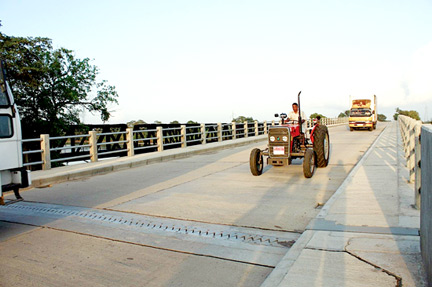New vision - new era
By Dhaneshi YATAWARA
[email protected]
Rising with domestic aspirations
Economy with a continuous growth rate of over 6% for four years
|

New Arugam Bay bridge
|
 Sri Lanka’s economic growth rate for the past three decades had been
moderate but lagging behind those achieved by the dynamic, emerging
economies in East Asia. In addition, there has been a perpetuation of
income disparities, both among income earners and geographic regions. It
is clear that in the past the economic growth has largely bypassed the
rural areas in the country and concentrated in the Western Province. In
the case of income groups, the disparities appear to be even wider. Sri Lanka’s economic growth rate for the past three decades had been
moderate but lagging behind those achieved by the dynamic, emerging
economies in East Asia. In addition, there has been a perpetuation of
income disparities, both among income earners and geographic regions. It
is clear that in the past the economic growth has largely bypassed the
rural areas in the country and concentrated in the Western Province. In
the case of income groups, the disparities appear to be even wider.
During the next ten years our population is expected to increase upto
about 22 million from the present 19.7 million. The labour force is
expected to reach a level of 10.9 million. The unemployment rate is
declining. There could be some tightening of the labour market
conditions with the possible increased demand for labour with the
ongoing expansion of the world economy, aging population in many
countries including Sri Lanka, and expected expansion of domestic
economy. However, we need to ensure that the gain made in employment is
sustained and the new entrants to the labour force, projected to be
around 2.8 million during the next ten years are well prepared to be
gainfully employed and their productivity level raised.
Another major challenge will be eradicating poverty, affecting about
23 percent of the country’s population.
Sri Lanka needs a considerable catch-up in growth rate not only to
secure its place in the region as a newly emerging country, but also to
ensure that the country’s economy is capable of providing better
livelihood for all citizens, including those who are in abject poverty.
Enduring vision
Based on this strategy, a long-term development program for 2006 -
2016 has been prepared within the broad policy framework of ‘Mahinda
Chinthanaya’.
The formulation of the program has undergone an intensive
consultative process involving sectoral Ministries and other relevant
agencies. The new approach integrates the positive attributes of market
economic policies with the domestic aspirations by providing necessary
support to domestic enterprises and encouraging foreign investments.
Within the macro economic parameters the program includes ten-year
policy frameworks for various sectors of the economy covering sector
visions, issues, challenges and strategies.
Such a substantial leap forward would not only require careful
planning and implementation but also favourable external conditions. The
challenge caused by the recent massive rise in world oil prices has had
adverse impact on the economy and the country needs to prepare for any
further shocks in the area.
Sri Lanka has faced the recent challenges reasonably well making the
necessary adjustments in petroleum product prices, facing the realities
in the world market conditions. The country also has made considerable
progress in the post-tsunami recovery and reconstruction efforts while
the speed of recovery in some parts of the country has been constrained
due to the prevailing LTTE threats.
Agriculture and industry

Mavil Aru anicut after liberation |

Moragahakanda project in process |

New and old bridges at Manampitiya |
Accelerating economic growth needs a significant up - scaling of
investment and improving overall productivity level. In all sectors, new
growth areas are emerging. In the agriculture, the non-traditional
products such as fruits and vegetables, poultry livestock, fisheries
etc., are expected to make a greater contribution to output and income
generation. The support to this sector is continuing. All three major
sectors - agriculture, industry and services are expected to grow
faster. Manufacturing and services industries are also expected to show
greater dynamism.
The more dynamic industries within these major sectors identified are
electricity, port services, transport, telecommunication services, small
and medium scale businesses including personal services and many new
manufacturing activities - catering to both external and domestic
markets.The ‘ten year plan’ focuses on an annual growth of more than 4%
- 5% in the agriculture sector. The input by the Government under
‘Mahinda Chinthanaya’ for agriculture gives particular emphasis on
achieving food security and raising incomes for small farmers. The
strategies adopted include, increasing competitiveness through
application of modern technology, improved cultural practice and
shifting to commercial agriculture. The role of the Government includes
agricultural research and extension, facilitating the supply of quality
seed and planting material, assistance to marketing and credit as well
as providing production incentives in the form of subsidies and
transfers.
World market
International competitiveness of Sri Lanka’s industry needs to be
improved if the development of the sector is to be sustainable. The
industrial policy places emphasis on assisting the small and medium
scale industry sectors, micro enterprises and self-employment ventures
as a part of the shared growth strategy. Government intervention focuses
on creating a sound incentive structure, which are for new investments
as well as facilitating the access to technology and credit, developing
skills and entrepreneurship, maintaining standards and performing
regulatory functions among others.
The Government under the ‘Mahinda Chinthanaya’ focuses more on
improving the macro economic environment, upgrading the public service
delivery including improving the efficiency of State-owned strategic
enterprises, promoting technology and as well as facilitation of private
investment in new industrial zones.
Tourism
The Mahinda Chinthanaya’s ten year horizon plan targets to promote
Sri Lanka as the most attractive tourist spot in the region. Tourism
being a sector which has a vast potential for contributing to employment
and foreign exchange earnings is expected to make major strides under
the plan. Plans have been prepared to cater to a large volume of high
spending tourists including those from emerging Asian markets. There
will also be greater emphasis on developing domestic tourism as well as
a further strengthening of the role of the Government in setting
standards, providing investment incentives and regulations in this
sector.
Social development
Under the ‘Mahinda Chinthanaya’ - development framework for 2006 -
2016, many areas such as education, health, livelihood development and
social protection, disaster management, water supply and development in
lagging regions are given priority. This approach will give a further
impetus to Sri Lanka’s satisfactory performance so far in moving towards
the Millennium Development Goals. The existence of large regional
differences in social indicators has necessitated the preparation of a
number of region-specific strategies including those for the North and
East and the Plantation workers.
Developing infrastructure
Randora - Infrastructure Investment plan, under the ‘Mahinda
Chinthanaya’ ten year development frame work’, envisages channelling a
large share of investment to developing the basic infrastructure and
other services in the rural areas - i.e. electricity supply,
telecommunication services, supply of drinking and irrigation water,
access roads, agricultural storage, health and education facilities.
The plan for electricity aims at a substantial expansion and
diversification of generation capacity by implementing the long delayed
coal power and hydro projects as well as new fuel/LNG based projects,
development of renewable energy sources, rationalizing the tariff
structure and increasing access to electricity by all consumers
particularly covering the remote areas.
The national, provincial and rural roads improvement program is
already underway. Roads in the remote, rural areas are to be developed
under ‘Maga Neguma’, various regional development projects and
provincial programs. Problems related to waste disposal, water and air
pollution are accorded priority. While the public sector plays the key
role in the development of water and sanitation sector, the community
participation in the sector is encouraged.
Under the Randora infrastructure development program the Water Supply
scheme for Jaffna, the greater Dambulla Project, Hambanthota port
development, Weerawila Air port, Norochcholai and Trincomalee coal power
plants, Northern highway, Hydro power plant in Upper Kotmale, Southern
transport development project are included at present.
Caring for terror victims
Thousands of people were displaced since they left their homes taking
a handful of their assets in fear of LTTE offensives. After liberating
the East last year, the Government along with the security forces
started resettling people in their original homelands.
After the liberation, people started returning to their homes. The
innocent people would never had the slightest hope for a peaceful
future. Now they are armed with the right to elect their representatives
unlike in the gloomy past, the era of LTTE’s omnipotent ruling. The much
acclaimed Eastern Provincial Council election and the reintroduction of
democracy was a welcome news for the entire country. Many were with
various views on holding the provincial Council elections. Yet, after
the liberation of the Eastern Province, the former Tiger stronghold,
people started to smell fresh fragrance in the wind.
If President Mahinda Rajapaksa, as the Commander - in - chief, did
not take the decision to let the Security Forces march in and liberate
the East from the clutches of the Tigers the restoration of law and
order, development and democracy would have been just another dream for
Sri Lanka.
In the North we sense the winds of change with the victories received
by our valiant soldiers.
Fruits of success
It is expected that year 2008 will be able to produce a fiscal report
encouraging the agricultural and industrial sectors as well as the
expanding service sector.
It is the first time in the post independence era that our economy is
experiencing a steady growth of over 6% continuously for four years.
Indicating growth in the relevant sectors, the first three quarters of
2008 shows a 6.9% growth rate in the G.D.P. This surpasses the
remarkable achievement in 2007 where the rate was 6.6%. The achievement
is gained in a backdrop where the crude oil and world food prices
fluctuated continuously and extensively, and also in a world economy
where the European and American economies are facing severe setbacks as
well as high-rated inflation not to mention the war against terrorism.
It is noteworthy that the unemployment rate came down to 5.3% during
the second quarter of 2008 from the 6% reported in 2007, the labour
force of the country grew up to 7.51 million in 2008 showing a 2% growth
rate, according to the Finance Ministry latest reports. |

